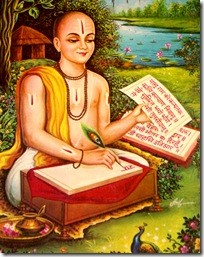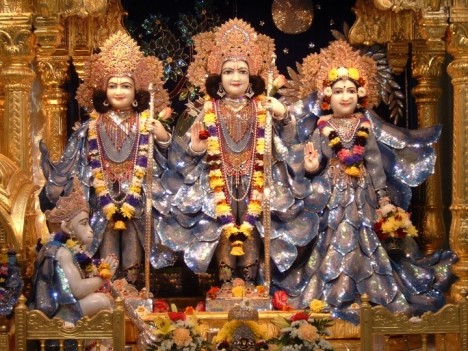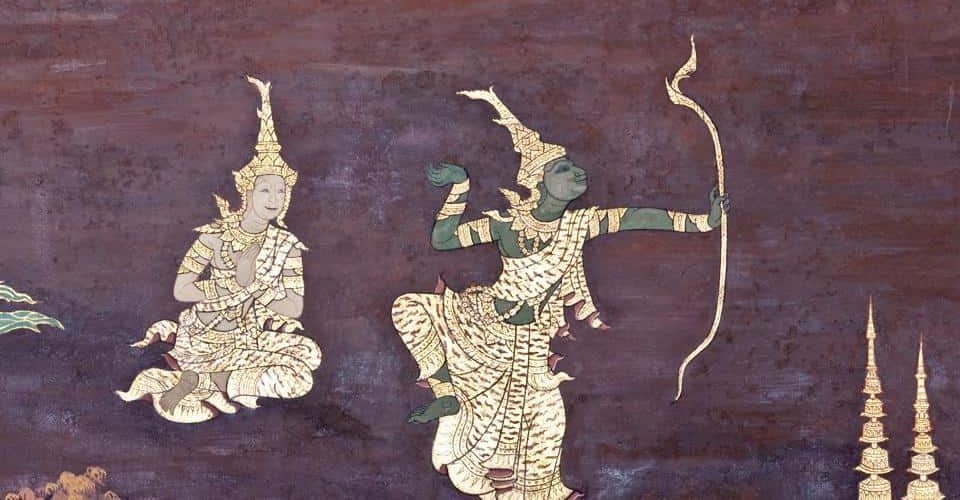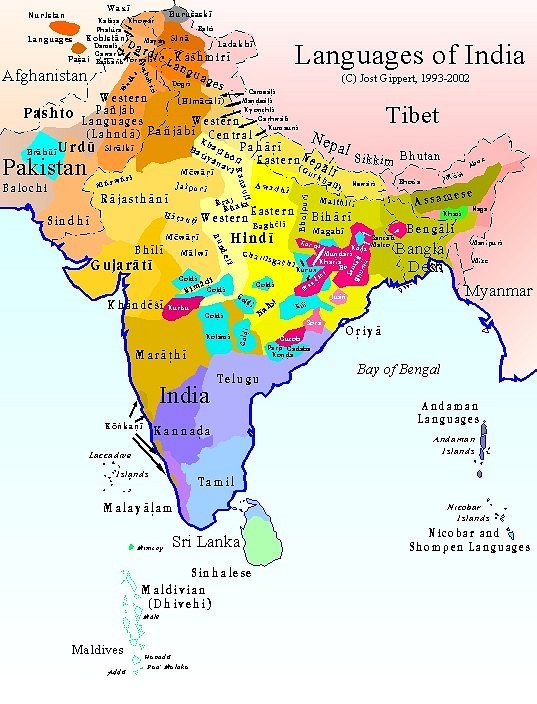Languages of Hindu Scriptures: Other Languages
In addition to Sanskrit and Tamil, many other Indian as well as non-Indian languages were used for composing Hindu scriptures. For e.g., we have a version of the Brahmāṇda Purāṇa in Javanese (an Indonesian language), versions of Ramayana in Thai, Burmese, Tibetan and other languages.
The map below shows the current distribution of various languages in India:
 Hindi
Hindi
The different dialects of Hindi evolved in the last 1000 years and constitute the most commonly spoken language of Hindus today in northern India. The Bhakti saints adopted the use of Hindi dialects in a big way to explain the subtle concepts of Hindu religion to the masses in a simple manner. Many saints of the Nirguṇa Bhakti tradition, who worshipped Paramātman as a Formless Divinity, used the ‘Santabhāshā’ – a mixture of several colloquial dialects of Hindi. The Guru Grantha Sahib (compiled originally around 1604 C.E.), the sacred scripture of the Sikhs, is also written predominantly in the Santabhāshā. Likewise, the beautiful hymns of Saint Kabir (15th century C.E.) are also in this form of Hindi. On the other hand, several Saguṇa Bhakti saints chose the Braj dialect (spoken in the Mathura region of northern India) for their devotional literature. The best example of Bhakti poetry in Braj are the works of Saint Surdas (16-17thth century C.E.). Saint Tulsidas (16-17thth cent C.E.) also chose an eastern dialect, the Awadhi, to write several of his celebrated works such as the Ramacharitmanas, considered a very important scripture by Hindus of north India. In the late 18th century, Khari Boli dialect spoken around Delhi and in western parts of the Indian state of Uttar Pradesh became the standard Hindi for literary purposes. The Pandits of Varanasi and subsequent the Ārya Samāja movement (founded in 1875 CE) generated a lot of religious Hindu literature in the Khari Boli. In particular, the latter movement produced vast literature in Hindi in order to popularize the Vedas, Upanishads and other Vedic scriptures amongst the Hindi speaking peoples of northern India.
Marathi
The first translation of Bhagavadgita into another Indian language was the Jnāneshvari by Sant Jnaneshvar (13th century C.E.), written in an older form of Marathi. The commentary is known for the sweetness and simplicity of its language, and its ability to convey complex philosophical doctrines in a lucid manner. A few centuries later, Saint Ekanātha composed the Ekanātha Bhāgavata, a Marathi commentary on the 11th skandha of the Bhāgavata Purāņa, as well as work based on Ramayana named Bhāvārtha Ramayana. Several other popular scriptural works in Marathi such as the Dāsabodha were authored by renowned Hindu saints of Maharashtra, such Swami Samartha Ramadasa. The devotional songs of Saint Tukarama, called abhangas, are sung even today. Numerous other Marathi works based on the Itihasas and Puranas, notably the Bhāgavata Purāṇa, have been composed in the last 6 centuries. In modern times, a vast literature in Marathi on Hindu religious themes has been written, and is probably greater in extent than the modern Hindi literature.
Javanese
Many Hindu scriptures were translated and adapted into the local languages of the regions outside of the Indian subcontinent in which Hindu Dharma spread in ancient times. As examples, we can point to Javanese translations of the Bhagavad Gita and the Brahmāṇda Purāņa.
Assamese
The valley of Brahmaputra in eastern India was called Prāgjyotisha and Kāmarūpa in ancient times and its evil ruler Narakasura was killed by Lord Krishna, who freed the thousands of innocent women that the ruler had enslaved. The region has large populations of wild elephants and the Hastyāyurveda in the Sanskrit language attributed to Pālākāpya Muni is said to have been compiled there. In the 13th cent. CE, Hema Sarasvatī wrote a Prahlāda Charita in Assamese, and it is the first known literary work in that language. Two centuries later, Shankara Deva, considered the greatest Assamese Hindu saint, authored several works in Assamese such as 2400 verse summaries of various episodes from the Bhāgavata Purāņa. His works lead to the spread of Vaishnavism over large parts of Assam, and in parts of the Indians states of Meghalaya, Arunachal Pradesh and Manipur. Portions of Mahabharata were also translated into Assamese by Rama Sarasvati.
Bengali
This is the second most widely spoken language in the Indian subcontinent and is prevalent in the Indian states of West Bengal and Tripura and in the country of Bangladesh. The region constituted the ancient Hindu regions of Anga, Varendra, Radheya, Shrihatta etc. The first known notable literature in Bengali were the Vaishnava songs of Chandidas, which even influenced the later great Bengali Hindu saints such as Chaitanya Mahāprabhu. He and his schools contributed a lot of devotional literature during the 15th cent CE and later, including works such as Chaitanya Bhāgavata by Brindavana Dāsa (16th cent CE) and Chaitanya Charitāmrita by Krishṇadāsa Kavirāja (16th cent CE). The Bengali rendering of Ramayana by Krttibāsa (15th cent CE) and Mahabharata by Kashiramdas (17th cent CE) are well known. The Baul mystics have also composed a lot of spiritual poetry in Bengali, much of which has been transmitted only through oral traditions. In the 19th cent CE the disciples of Shri Ramakrishna Pramahamsa authored notable works such as Kathāmrita which are read with great devotion by the followers of the Ramakrishna Mission – a neo Hindu tradition started by his disciple Swami Vivekananda.
Gujarati
The most notable religious composer in the language is Narsi Mehta (16th cent CE) and his devotional lyrics called Prabhātiyas are sung reverentially at morning by numerous Hindus in the Indian state of Gujarat. His bhajan ‘Vaishnava jana to tene kahiye’ was Mahatma Gandhi’s favorite bhajan and was sung during his prayer meetings. Poetess Saint Meerabai lived for several years in Gujarat and she too composed some of her devotional hymns in the language. Religious literature in Gujarati got a further impetus by the founding of the Swaminarayan Samprādāya about 2 centuries ago, and that Vaishnava Hindu movement has today spread all over the world with the Gujarati diaspora.
Malayalam
This language is spoken in the Indian state of Kerala and separated from the parent Tamil language only around 1000 CE. Rāmacharitam based on the Yuddha Kāṇda of Ramayana is considered the oldest literary work in Malayalam. This was followed by Malayalam renderings of the Adhyātma Ramayana, Bhāgavata Purāņa and the Mahābhārata by Tunjatthu Ramanujan Ezhutthacchan. Other than the numerous other Malayalam works based on these Hindu scriptures, the Vaidika Namputiri Brāhmaṇas of Kerala have also written numerous practical manuals in their mother tongue to assist them in the minutiae of Vedic religious ceremonies.
Kannada
Spoken over large parts of the Indian state of Karnataka, it is said to be the second oldest Dravidian language spoken today. The first literature in Kannada pertains to Jainism, but one of the authors named Pampa also composed Kannada works Vikramārjuna-Vijaya and Sāhasa Bhīmavijaya based on the Mahābhārata. The Virashaiva school of Shaivite Hindus started by Basavanna contributed a lot of devotional literature in Kannada. His 700 ‘vachanas’ as well as those of Mahadevi Akka, a Saint Poetess of the tradition are masterpieces in the language. Bhīmakavi’s (14th cent CE) Bāsavapurāṇa is a famous Kannada biography of Basavanna. Likewise, the Kannada version of the Mahabharata, as well as another work ‘Jaimini Ashvamedha’ based on King Yudhishthira’s Ashvamedha ceremony by Naranappa (15th cent CE) and Lakshmīsha (16th cent CE) are considered very good specimens of Kannada religious poetry. In the 15th – 16th cent CE, the famous Dvaita Vedāntin Purandara Dāsa is considered the founder of the Carnatic school of Hindu music and contributed beautiful Vaishnava poetry. Saint Kanakadāsa, who lived around the same time, also wrote Vaishnava works Haribhaktisāra and Mohanataranginī.
Telugu
The first work in Telugu is the Telugu rendering of Mahābhārata in parts by Nannaih (11th cent CE), Tikkanna (13th cent CE) and Errapragada. Soon thereafter, Poetess Molla composed a Telugu rendering of the Ramayana. In the 14th-15th cent CE, Shrinātha wrote several Telugu works such as translations of the Sanskrit Bhīmeshvara Purāņa, the Kāshikhaṇda of the Skanda Purāņa, a work called Haravilasamu containing the sacred narratives associated with Lord Shiva, and a compendium of the sacred rites and holy places in the Telugu speaking lands. A very popular Telugu work is the Telugu rendering of the Bhāgavata Purāņa of Saint Poet Pottanna (14th – 15th cent CE). Around the same time, saint Annamacharya composed exquisite devotional poetry extolling Lord Venkateshvara. In the 16th century, five works, considered as Mahākāvyas, were authored in the Telugu language – Manucharita of Allasani Peddanna (based on the story of Svārochisha Manu in the Markaṇdeya Purāņa); Amuktamālyadeva of King Krishnadevaraya (dealing with the story of Alvar Saintess Andal and her father Perialvar); Vasucharita by Bhattu Murti; Panduranga Mahatmyamu of Tenali Ramalinga and Raghava Pandiyamu of Pingala Suranna. The last work is remarkable in that each verse unfolds the Ramayana as well as Mahābhārata. In the 17th cent CE, Saint Bhadrāchala Rāmadāsa and in the 18th – 19th cent CE, Saint Tyāgarāja composed mesmerizing Telugu devotional songs in praise of Lord Rama and these are sung by millions of Indians in south India to this day.
Oriya
The earliest work in this language spoken in the Indian state of Orissa is the Kalasa Chautisa of Vatsadāsa (14th cent CE), describing the wedding of Lord Shiva and Parvati. In the next cent., we have the Chandi Purāņa, which extols Devi Durga. The author, Sāralādāsa, also condensed the Sanskrit Mahābhārata into 700 verses in Oriya. His Vilanka Ramayana in Oriya depicts Devi Sita as the actual killer of Ravana. In the 16th-17th cent CE, the Oriya poet Jagannāthadāsa wrote the Bhāgavata in a very elegant and lucid poetical style. Several other Oriya devotional works were written around the same time, such as the adaptation of Jayadeva’s Gīta-Govinda.
English
Many Hindu saints in modern times have chosen the medium of English because of its current popularity as a global language of communication. The writings of such great Hindus are often considered sacred by many Hindus, and are acquiring the status of scripture. Examples of such saints who wrote in English are Sri Aurobindo, Swami Vivekananda and Satguru Shivaya Subrahmanya Swami. English is also rapidly becoming the language through which many modern Hindus acquire knowledge of Hindu Dharma, because most of the important Hindu scriptures are now easily available in English translations.
Should we study our Shāstras only in Sanskrit?
Some people believe that scriptures should be studied only in their original language, from a master who knows that language and the scripture thoroughly. It is of course always preferable to read any book in its original language to understand it completely, but selfish people often use this fact to acquire a monopoly over teaching the scriptures to the common man. When the Bible was first translated from Latin to another language, it caused a stir in the Christian clergy, and the Pope threatened Martin Luther (the translator) with dire consequences. In India, the Koran was not translated from Arabic till just a few centuries back. Likewise, when Sant Tulsidas translated Valmiki’s Ramayana from Sanskrit to the Awadhi dialect of Hindu, the orthodox Pandits opposed him. They believed that it was blasphemy and a sacrilege to translate Hindu scriptures from Sanskrit, the Divine language, into a human language. However, for more than 1500 years, Hindu Sants have been teaching our holy books to the masses in their own language our or compassion, and because they believed that language should not be a barrier in the common man learning the beautiful teachings of these holy books.
Story: Bhagavān Shiva asks Sant Tulsidas to explain the Scriptures in a Language that the Common Man Understands
 Sant Tulsi Das is considered an incarnation of Sage Valmiki in our modern times. Tulsidas noted that India at that time was ruled by foreign Muslim rulers who were very harsh on the Hindus. All of our major temples had been demolished by them. Our scriptures were being burned. People were being forcibly asked to give up their religion and become Muslims. And our priests, the Brāhmaṇas, were being tortured. The government officials often troubled the common man by extracting very heavy taxes. Therefore, Tulsidas thought that he should teach the Ramayana to everyone, because it describes the life story of Lord Rama, who was an ideal ruler, an ideal son and much more. But the Ramayana which was written by Sage Valmiki was a very large book. It had 24000 verses. Moreover, it was in the Sanskrit language, which the common man did not understand those days.
Sant Tulsi Das is considered an incarnation of Sage Valmiki in our modern times. Tulsidas noted that India at that time was ruled by foreign Muslim rulers who were very harsh on the Hindus. All of our major temples had been demolished by them. Our scriptures were being burned. People were being forcibly asked to give up their religion and become Muslims. And our priests, the Brāhmaṇas, were being tortured. The government officials often troubled the common man by extracting very heavy taxes. Therefore, Tulsidas thought that he should teach the Ramayana to everyone, because it describes the life story of Lord Rama, who was an ideal ruler, an ideal son and much more. But the Ramayana which was written by Sage Valmiki was a very large book. It had 24000 verses. Moreover, it was in the Sanskrit language, which the common man did not understand those days.
So he first thought of shortening the Ramayana and create a version of it in Sanskrit with fewer verses. Every day, he wrote some verses in Sanskrit on a piece of paper. These verses described some part of the life of Lord Rama. But the next morning, Tulsidas saw that the sheet of paper on which he wrote the verses had become blank! This happened several days in a row. Then one night, Lord Shiva appeared to him in a dream and said to him – “Tulsidas, do not write the Ramayana again in Sanskrit, because only scholars can understand this language these days. I want you to go to Ayodhya, where Lord Rama lived. There you should write your Ramayana in the language Awadhi, which the common people speak in that city.”
Tulsidas understood the command of Lord Shiva and proceeded to Ayodhya. He started composing his Ramayana in Awadhi, and called this version the ‘Ramacharitmanas’, which means – “The Holy Manasarovar Lake of the acts of Rama.” Tulsidas then started teaching the Ramacharitmanas to people in Varanasi. The book was so beautiful, musical and gave just such a wonderful description of the life of Lord Rama that soon, large crowds started attending his lectures.
 For the first time, they could understand the beautiful life of Lord Rama, because the Ramacharitmanas was in Awadhi, a type of the Hindi language which was spoken by the common man. This caused some jealousy amongst the other local Pundits. They complained that Hindu scriptures should only be written in Sanskrit and not in any other language. They objected to the fact that Tulsidas worshipped Lord Shiva sometimes and yet he wrote his scripture on the life of Lord Rama. How could he be loyal to two Devatas at the same time?
For the first time, they could understand the beautiful life of Lord Rama, because the Ramacharitmanas was in Awadhi, a type of the Hindi language which was spoken by the common man. This caused some jealousy amongst the other local Pundits. They complained that Hindu scriptures should only be written in Sanskrit and not in any other language. They objected to the fact that Tulsidas worshipped Lord Shiva sometimes and yet he wrote his scripture on the life of Lord Rama. How could he be loyal to two Devatas at the same time?
The Pundits forgot that all these Devatas are the different forms of the same God. To test Tulsidas, they asked him to place his manuscript of the Ramacharitmanas inside the Kashi Vishvanath Temple, the holiest Shiva Mandir in Varanasi. On top of this book, they placed copies of the four Vedas and then shut the doors of the Mandir. When the doors were opened the next morning, a miracle had happened. The Ramacharitmanas copy was now on the top, and ‘Satyam Shivam Sundaram’ was written on its front cover. This meant that Lord Shiva Himself had decided that Tulsi’s Ramacharitmanas was as holy as the Vedas, which are themselves holiest scriptures of Hinduism.
The Pundits felt really ashamed and they asked the Saint for forgiveness. Thereafter, he was allowed to give lectures on the Ramacharitmanas without any trouble. Many people made copies of the book and they started singing it in every village. Tulsidas-ji wrote his Ramacharitmanas in the language of the common people, and not in Sanskrit. But Lord Shiva decided that it was as sacred as the holy Vedas in Sanskrit. Therefore another message from the life of Tulsidas is that even though Sanskrit is the holy language for us Hindus, God will listen to our prayers no matter which language we use to worship him. The important thing to keep in mind is that we should remember God with faith and devotion, no matter what the language of our prayers is.
Featured Image: Hindustan Times
Disclaimer: The opinions expressed within this article are the personal opinions of the author. IndiaFacts does not assume any responsibility or liability for the accuracy, completeness, suitability, or validity of any information in this article.
Vishal Agarwal is an independent scholar residing in Minneapolis (USA) with his wife, two children and a dog. He has authored one book and over fifteen book chapters and papers, some in peer reviewed journals, about ancient India and Hinduism. He and his wife founded the largest weekend school teaching Hinduism to students, and also a teenager organization to keep them engaged in Dharma. Vishal has participated in numerous interfaith forums, and has represented Hindus and Indians in school classrooms and in seminars. Vishal is the recipient of the Hindu American Foundation’s Dharma Seva Award (2010), the Global Hindu Academy’s Scholar award (2014) and service awards from the Hindu Society of Minnesota (2014 and 2015). He is very strongly engaged in the social and Dharmic activities of the Indian and Hindu communities of Minnesota, and has authored a series of ten textbooks for use in weekend Hindu schools by children from the ages 4-14. Professionally, Vishal is a biomedical Engineer with graduate degrees in Materials Engineering and Business Administration (MBA). His scientific and statistical training enables him to bring precision and a high level of rigor in his research – qualities that are very often missing in contemporary publications on Indology and in South Asian Studies.


